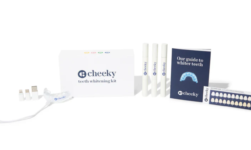Written by Claire Bonneau

As the largest organ in the human body, our skin has a lot of surface area for the potential development of health conditions. Exposure to high amounts of ultraviolet (UV) rays from the sun may give you that great tan you’ve been after all summer, but it can also dramatically increase your risk of developing skin cancer.
There are two main types of skin cancer — melanoma (which originates in our melanocyte cells that pigment our skin) and non-melanoma (skin cancer that starts in other types of skin cells). The most common types of non-melanoma skin cancers are basal cell carcinomas and squamous cell carcinomas, both of which have a lower mortality rate than melanoma (1).
With the rates of skin cancer diagnosis increasing every year, aggressive cancer types like cutaneous malignant melanoma are steadily climbing up the leaderboard of most common cancers around the world. Estimated to have over 106,000 new cases in 2021 alone (roughly 5.6% of all new cancer diagnoses this year), melanoma is currently ranked as the 19th most common cancer in the world (2)(3). With these numbers trending upwards over the past 25 years, skin cancer is starting to take a serious toll on the health of our global population (2).
While individual genetics, time spent outside, cultural practices, and access to sun-protective barriers play a role in a person’s risk for developing skin cancer, it turns out that your geographic location may increase your risk more than we previously thought.
Why paying attention to the UV Index matters
Skin cancer is primarily caused by chronic exposure to UV rays — the heat energy emitted from our sun. Divided into three different classes based on their wavelengths, UVA, UVB, and UVC rays can permeate into our skin to different depths (4). As the rays interact with the cells in our skin, they cause disruptions and damage to the cell’s DNA. If this damage cannot be corrected by our body’s innate cell corrective mechanisms, faulty cell replication can occur, resulting in the formation of skin cancer.
Able to permeate our skin at different levels, protection against all three types of UV rays is essential for adequate sun protection. While the smaller wavelength UVC rays often only impact the top layer of our skin, UVA rays can deeply penetrate every layer of the skin, capable of causing cellular disruption in the deepest dermis layer (5).
- UV rating 1-2 — While this is the lowest rating, protection is still necessary. Wearing sun protective eyewear, sunscreen, a hat, and adequate clothing to cover your skin is advised at this UV index rating to prevent the risk of sunburns.
- UV rating 3-5 — At this moderate UV index level, a sunburn can occur in 30-45 minutes in any skin that is not protected. On top of the sun safety practices mentioned before, it is recommended that people seek out shade throughout the day at this UV rating.
- UV rating 6-7 — This high UV index level can result in a sunburn in 15-25 minutes. It is advised that people limit their time in the sun at this UV index rating.
- UV rating 8-10 — At this very high rating of UV exposure, you can sustain a sunburn in less than 15 minutes. To best protect yourself, it is recommended that people avoid any sun exposure from 10 am – 2 pm when the risk for high UV exposure is at its highest.
- UV rating 11+ — Any rating of 11 or higher is considered to be extreme levels of UV radiation exposure. Capable of causing a severe sunburn in under 10 minutes, it is advised that you take all precautions possible to limit your exposure to the sun at this UV rating.
The top 20 countries with the highest skin cancer rates

#1 — Australia (average UV index of greater than 12)
#2 — New Zealand (average UV index of greater than 11)
#3 — Norway (average UV index of 5 or less)
#4 — Denmark (average UV index of 6 or less)
#5 — Netherlands (average UV index of 5 or less)
#6 — Sweden (average UV index of 5 or less)
#7 — Germany (average UV index of 5 or less)
#8 — Switzerland (average UV index of 8 or less)
#9 — Belgium (average UV index of 7 or less)
#10 — Slovenia (average UV index of 8 or less)
#11 — Luxembourg (average UV index of 7 or less)
#12 — Ireland (average UV index of 6 or less)
#13 — Finland (average UV index of 5 or less)
#14 — The United Kingdom (average UV index of 8 or less)
#15 (tied) — Austria and France (average UV index of 7 and 6, respectively)
#17 — United States (average UV index of 9-10 depending on the state)
#18 — Czech Republic (average UV index of 7 or less)
#19 (tied) — Canada and Italy (average UV index of 6 and 9, respectively)
So as we can see, the top 20 countries are quite dispersed across the globe. With some countries like Australia and New Zealand reporting incredibly high average UV index levels, others like Norway and Denmark still have cases despite having much lower UV values.
Let’s explore how human genetics (and the impact of modern pollution) are contributing to the increased numbers of skin cancer diagnoses around the world.
Fair skin types are the most vulnerable
Without the higher amounts of melanin in the skin, people with fair skin are at an elevated risk for experiencing UV radiation damage to their skin cells. Within the group of people with fair skin, individuals with light-coloured eyes and blonde or red hair are at an additional risk for developing skin cancer due to the ultra-fair colour of their skin.
Based on a skin chart created by the World Health Organization (WHO), there are six different skin types, each with different risk levels for experiencing UV damage (10). People with fair skin types (I and II on the chart) have lower levels of naturally occurring melanin when compared with darker skin tones (V and VI), meaning they need to take additional care to prevent severe sunburns and skin damage.
We need to protect ourselves from the sun
As the global cases of skin cancer continue to trend in the wrong direction, it is time that we take action before the number of cases overwhelms our healthcare systems.
Two battles need to be fought to successfully achieve this goal: personal/cultural mindset changes and international action.
On a personal level, increased education about the importance of partaking in sun-safe activities is a great way to reduce your risk of developing skin cancer. Increasing time spent in the shade, checking your local area’s UV index regularly, and reducing your time intentionally sun tanning are all great steps for everyone to take to prevent sunburns and skin damage from the sun. Additionally, wearing broad-spectrum high SPF (sun protection factor) sunscreens while spending any time outdoors is one of the best ways to protect your skin. Shown to be incredibly effective at reducing the penetration power of UVB rays, freshly applied SPF 50 sunscreen can block up to 98% of the UVB rays your skin is exposed to while you are out in the sun (5).
Climate change is only making it worse
Unsurprisingly, climate change is not having a positive effect on skin cancer trends around the world. As our pollution continues to deplete the ozone layer, more and more harmful UV rays are making it through our atmosphere and reaching the Earth’s surface. It is estimated that as little as a 10% reduction in ozone thickness will result in an additional 300,000 non-melanoma and 4,500 melanoma skin cancer cases (10).
Because of the natural rotation and orbit of the Earth around the Sun, countries that are near the equator will experience the harshest increases in UV radiation exposure as a result of ozone depletion. Factors like the Earth’s elliptical orbit shape, lower overall pollution levels, and less population density results in countries in the southern hemisphere near the equator getting an estimated 15% more UV radiation exposure than those in the northern hemisphere (13). As our ozone layer continues to thin, the amount of UV exposure will only increase in these regions, resulting in worse health outcomes for the people living in these warmer climates.





